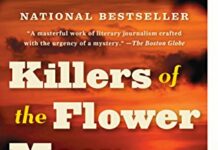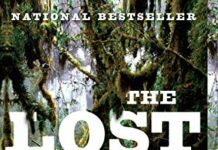
Ebook Info
- Published: 2017
- Number of pages: 347 pages
- Format: Epub
- File Size: 85.08 MB
- Authors: David Grann
Description
In the 1920s, the richest people per capita in the world were members of the Osage Nation in Oklahoma. After oil was discovered beneath their land, the Osage rode in chauffeured automobiles, built mansions, and sent their children to study in Europe.
Then, one by one, the Osage began to be killed off. The family of an Osage woman, Mollie Burkhart, became a prime target. One of her relatives was shot. Another was poisoned. And it was just the beginning, as more and more Osage were dying under mysterious circumstances, and many of those who dared to investigate the killings were themselves murdered.
As the death toll rose, the newly created FBI took up the case, and the young director, J. Edgar Hoover, turned to a former Texas Ranger named Tom White to try to unravel the mystery. White put together an undercover team, including a Native American agent who infiltrated the region, and together with the Osage began to expose one of the most chilling conspiracies in American history.
User’s Reviews
Review “The best book of the year so far.”—Entertainment Weekly“A marvel of detective-like research and narrative verve.”—Financial Times“A shocking whodunit…What more could fans of true-crime thrillers ask?”—USA Today“A master of the detective form…Killers is something rather deep and not easily forgotten.”—Wall St. Journal“Extraordinary”—Time Magazine Amazon.com Review The Amazon Editors’ Pick for the Best Book of 2017: In the 1920s, the Osage found themselves in a unique position among Native Americans tribes. As other tribal lands were parceled out in an effort by the government to encourage dissolution and assimilation of both lands and culture, the Osage negotiated to maintain the mineral rights for their corner of Oklahoma, creating a kind of “underground reservation.” It proved a savvy move; soon countless oil rigs punctured the dusty landscape, making the Osage very rich. And that’s when they started dying. You’d think the Osage Indian Reservation murders would have been a bigger story, one as familiar as the Lindbergh kidnapping or Bonnie and Clyde. It has everything, but at scale: Execution-style shootings, poisonings, and exploding houses drove the body count to over two dozen, while private eyes and undercover operatives scoured the territory for clues. Even as legendary and infamous oil barons vied for the most lucrative leases, J. Edgar Hoover’s investigation – which he would leverage to enhance both the prestige and power of his fledgling FBI – began to overtake even the town’s most respected leaders. Exhuming the massive amount of detail is no mean feat, and it’s even harder to make it entertaining. But journalist David Grann knows what he’s doing. With the same obsessive attention to fact – in service to storytelling – as The Lost City of Z, Killers of the Flower Moon reads like narrative-nonfiction as written by James M. Cain (there are, after all, insurance policies involved): smart, taut, and pacey. Most sobering, though, is how the tale is at once unsurprising and unbelievable, full of the arrogance, audacity, and inhumanity that continues to reverberate through today’s headlines. –Jon Foro, The Amazon Book Review –This text refers to the hardcover edition.
Reviews from Amazon users, collected at the time the book is getting published on UniedVRG. It can be related to shiping or paper quality instead of the book content:
⭐ Since the 17th century, the Osage tribe claimed land from Missouri west to the Rockies. With the Louisiana Purchase, the tribe was forced to cede land to accommodate the flood of western expansion. In Chronicle One of Grann’s book, the history of the tribe is laid out. By the 1870’s, what remained of the Osage tribe settled in NE Oklahoma because their chief deemed the land too hilly for white settlers to want to file claims there. The tribe negotiated with the Department of the Interior that any reservation land used for oil drilling or mining, had to be leased from the tribe and that the full blooded Osage would share in any profits from these natural resources. Logs where kept of Osage tribe members and indeed, when oil gushed from leased reservation land, head rights were claimed. The Osage tribe were among the wealthiest people in the country. Starting in 1921, Osage tribal members began to die. Some were shot in the head while others suffered from a mysterious “wasting” disease. Many suspected murder and lived in fear of who might be next.Chronicle Two describes in detail the role of the Bureau of Investigation (the early FBI) to unravel the murders during what became known as “the Reign of Terror.” The Bureau was formed under Teddy Roosevelt in 1909. By 1924, J. Edger Hoover became head of the Bureau. He wanted to highlight the expertise of the Bureau by solving the Osage murders. He hired a former Texas Ranger, Tom White, to lead the investigation. The reader discovers clues along with White as he methodically collects evidence and interrogates witnesses and suspects . This is the most exciting part of the book. Many, but not all of the culprits are brought to justice.How are the Osage doing now? This is the gist of Chronicle Three and it is, unfortunately, the weakest part of the story. Grann checks in with the descendants of some of the murdered Osage. Their sense of unease and lack of justice is palpable. The oil has dried up and the tribal population has diminished. Some press Grann to help them bring closure to the holes in their family histories. But the ancestors are in their graves along with the murderers and the paper trail is weak or inconclusive. As Grann runs out of answers, this reader ran out of interest. It is a compelling and important story up to this point. Now that wind turbines dot the prairie of the Osage reservation, their future seems as bleak as their past and the lack of justice seems as limited as their future. Despite Grann’s extensive notes and lists of resources, the reader is left, like the Osage themselves, with more questions than answers.
⭐ I loved Grann’s The Lost City of Z so I was eager to try this. Unfortunately, it was drab in its telling. I’m glad I’ve finished it, though. It’s a fascinating & important story, that shows the appalling extent of exploitation that Native Americans endured.The first three quarters of the book are spent in minute details. That was interesting, but too long. That case had little to do with the birth of the FBI, other than it was one of their first (if not the first) investigation and coincided with the rise to power of J Edgar Hoover. The final quarter rushes through the implications and unsolved mysteries of the murders, then the book abruptly ends.In short, far too much detail about one case, then not enough detail about what it all meant and the larger picture.Not terrible, but unlike The Lost City of Z, not great.Larry Nocellaauthor of Razor Wire Karma: a novel, available on Amazon
⭐ I’ll keep it simple.I’m horrified and ashamed of the atrocities people will commit to gain extra cash in their pockets. This story needed to be told, and it fascinating the amount of detail that went into describing the horrors of that period of time. Certainly a lot of jumping off points into further readings from history.Reads quickly, easily, and is highly thought provoking. Worth the time. I highly recommend it.One aspect that had it been included, would have really helped solidify some of the information is a time line with events and people. There are so many people involved, and so many connections and mysteries, that I was beginning to forget when something happened and who was involved, or how someone was related, or what their role was. Its not that I forgot, but I would love to refer back to that in conversations about the book. I suppose I could have taken notes, but that didn’t occur until later. And so I just leave that as a suggestion. A couple of pages at end of book with a quick who’s who.
⭐ Well researched and written. Sadly a true story. A testimonial to greed and arrogance. Well worth reading.
⭐ This book kept putting me to sleep. I usually love non-fiction but this was a yawn. I felt like I was reading a paper written by a college kid (freshman not senior) (community college not Ivy League) with disjointed quotes and references loosely strung together begging for cohesion. I never knew anything about the Osage murders and injustices, so it was eye-opening from that perspective. But the author made zero effort to elicit emotion from the reader and made not attempt to develop a story line or plot, per se. This is literally just a bunch of factoids pulled from old documents strung together and thrown into a book. I think the author bit off way more than he could chew. It’s a shame that the writing quality (or lack thereof) did not do justice to a topic of this magnitude.
⭐ Bad things happen, and this was certainly a terrible outcome of the era examined. But it would have been more meaningful if approached his subject from the values of that era. Context matters, and the historical analysis would be more helpful if some explanation of the attitudes of the time had been explained. While the author clearly was critical of the private investigation system which prevailed in the 19th century when he wrote of his brief references about Detective Burns, he gave J. Edgar Hoover a free pass! In my opinion, the book was shallow and built upon a preconceived modern opinion of the author, and it shows.
⭐ This is one of the best true crime historical accounts I’ve ever read. From start to finish it is compelling reading that didn’t let me put the book down. A darkly fascinating subject well rendered.
⭐ Author David Grann spent years doing research and uncovering new evidence in writing Killers of the Flower Moon. Since I was a fan of his from reading The Lost City of Z, I expected this latest book to be the sort of non-fiction I love: the kind that reads like the best fiction. I was not disappointed. What I did not expect was just how infuriated I would become by reading it.Having been a huge horse racing fan when I was a teenager, I knew about the wealth of the Osage Nation in the 1920s. One of the Osage owned a winner of the Kentucky Derby. But that knowledge was just cursory. I had no idea how rich the Osage really were, and I certainly didn’t have a clue that the government didn’t trust them with all that money. I should not have been so naive. It had to madden many whites that, although they’d shoved the Osage onto a piece of land they deemed unfit for themselves, oil would be discovered and the Osage would turn out to be the wealthiest people in the world. The one way they had of trying to horn in on this wealth was by declaring that the Osage were not fit to use their own money wisely. In many cases whites were put in charge of the families’ money, and they gave their wards allowances (and themselves large fees for their business knowledge).Why on earth should I be so surprised that this greed would escalate to murder? It is the natural progression after all. To this day, the Osage have trust issues, and who can blame them? They tried to get dozens of murders investigated, but instead the killings were covered up. What Grann did in Killers of the Flower Moon was to dig deeper and deeper and expose just how huge the problem actually was. As I read, words like horrifying, unspeakable, and several others flashed through my mind. This is an uncomfortable read for anyone with a conscience; nevertheless, it is a fascinating and important one.(Review copy courtesy of NetGalley)
⭐ From 1921 to 1926 a series of murders were perpetrated against the Osage Indian Nation in Pawhuska, Oklahoma. The murders were calculated to cheat the Osage out of their rights to land that had been forced upon them by the United States government. Once large deposits of oil were discovered the Osage became some of the wealthiest people in America, but unscrupulous individuals, including prominent citizens, local law enforcement officers and members of the judiciary all conspired to take their wealth from them.In his meticulously researched book, “Killers of the Flower Moon: The Osage Murders and the Birth of the FBI,” author David Grann reveals the corruption, prejudices, and Old West attitudes that resulted in this “Reign of Terror.”In their day the murders were headline news, but Grann not only sifts through old newspapers, but court records, eyewitness accounts, descendent interviews, and FBI files to get at the truth. In doing so he recounts the early formative days of the Federal Bureau of Investigation, its director J. Edgar Hoover, and the men hand-picked to impartially investigate the murders and establish the FBI as the nation’s premier law enforcement agency.What may shock readers, however, is the magnitude of the conspiracy and the great many murders that were never investigated.The book is a window into a very dark period in American history; an account that definitely deserves telling, will have the reader invested in the story that unfolds, and provides yet another chapter in the saga and legacy of poor treatment of Native Americans.
⭐ This is one of the most heartbreaking and terrifying books I have ever read. I hope that it becomes a staple of reading lists for American history classes. It is an incredibly well told story of a staggering real world evil in an America only two or three generations removed from our own. You should read it. It won’t take long – it is, though it feels crass to say so, a genuine page-turner. And I at least will likely wrestle with it for a long while. Man o man.
Keywords
Free Download Killers of the Flower Moon: The Osage Murders and the Birth of the FBI in Epub format
Killers of the Flower Moon: The Osage Murders and the Birth of the FBI Epub Free Download
Download Killers of the Flower Moon: The Osage Murders and the Birth of the FBI 2017 Epub Free
Killers of the Flower Moon: The Osage Murders and the Birth of the FBI 2017 Epub Free Download
Download Killers of the Flower Moon: The Osage Murders and the Birth of the FBI Epub
Free Download Ebook Killers of the Flower Moon: The Osage Murders and the Birth of the FBI





